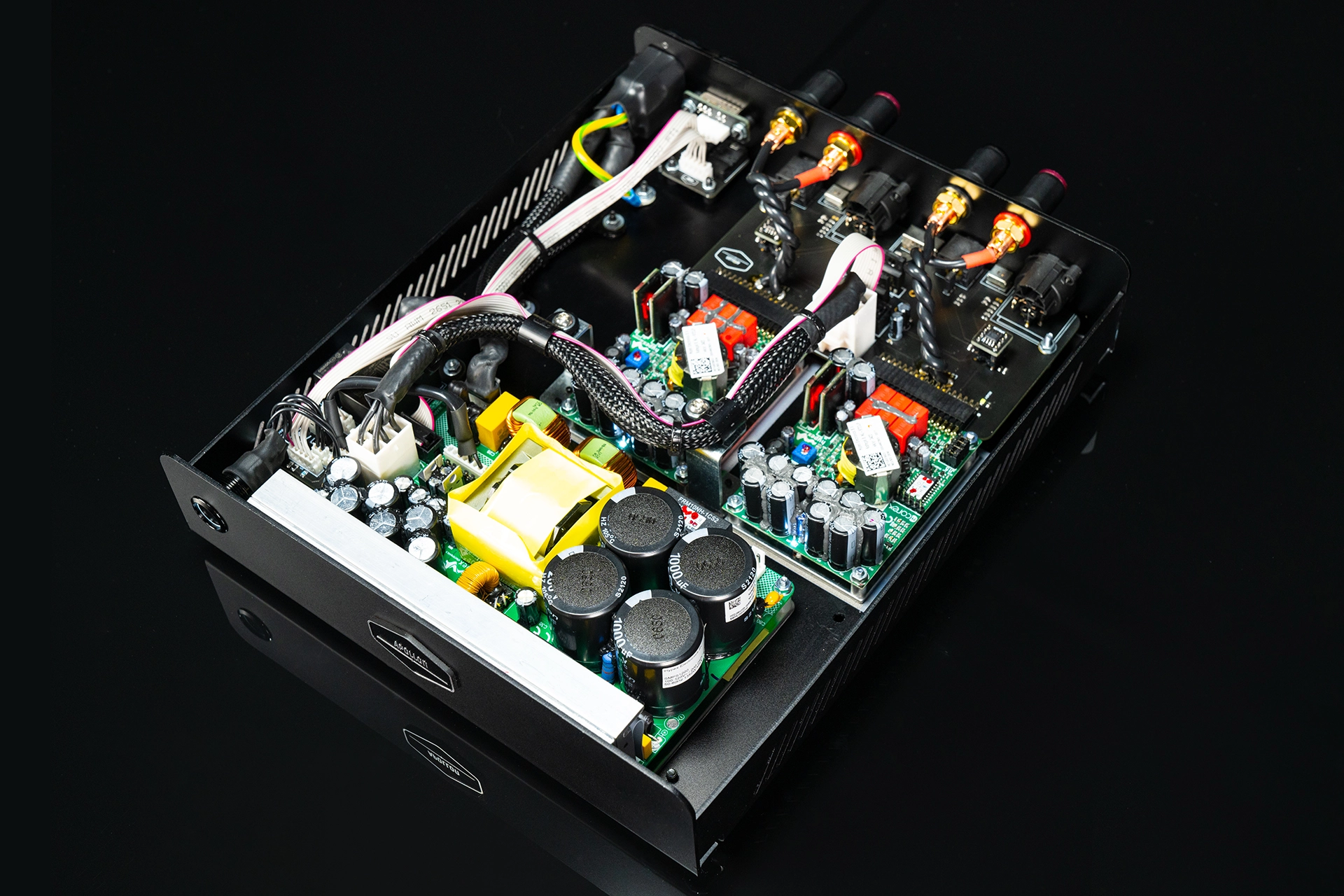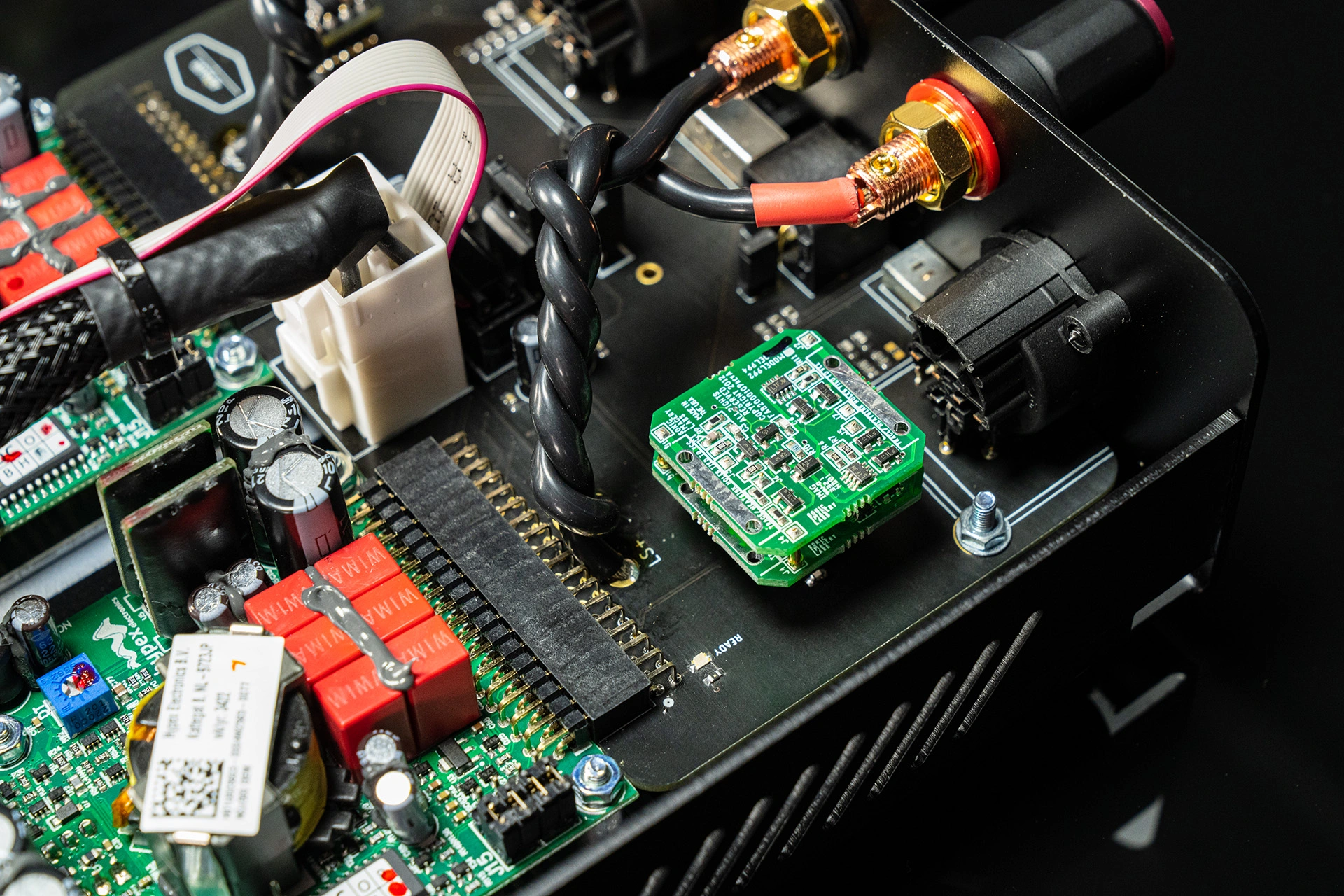This is a review and detailed measurements of the Apollon NCx500ST stereo class D amplifier based on Hypex NCOREx NCx500 modules. It was kindly drop shipped from the member and costs 1,090.00€ (US $1,168) with standard opamp.

While the case is stamped aluminum, it is a heavily customized one with attractive side vents. You get to select your color of choice. The back panel is where you notice the high value add:

You have no less than four gain settings and even an LED brightness switch! FYI, I will have to confirm which op-amp is included with this sample.
EDIT: the default TI OPA1612 op-amp was in this sample.
EDIT 2: turns the amp used Sonic Imagery op-amps (by mistake).
To make sure I didn't go mad given the combination of input types and four gain settings, I stayed with XLR testing.
If you are not familiar with the tests that are about to follow, please watch my video on understanding amplifier measurements.
Edit: just realized I left out the "n" out of the name on all the notations.
Apollon NCx500ST Amplifier Measurement
I started with the lowest gain setting:

While just a couple of dBs shy of the reference design, performance is good enough to easily land in our top 10 best amplifiers tested:

You need a ton of input voltage to get max power in this low gain setting so let's step up through the gain settings:



You can see the benefit of low gain in am amplifier for best noise performance especially since the dynamic range of the DAC improves as well with higher output.
Here are two SNR measurements:

I picked next to highest gain because it lets you drive it to max power with less than 4 volts on XLR:

In that reward, it would have been nice to have a different gain level optimized for 4 volts output from the source (here, we jump from 2.1 to 5 volts).
Notice how channel separation is also gain sensitive:

Frequency response is expectedly excellent and load independent:

Intermodulation is kept to very low levels:


This is one powerful amplifier:



The amp has a very robust protection circuit and did not mind at all being pushed way beyond clipping. This made it easy to measure with PowerCube:

An ideal amp would keep its voltage constant regardless of load. We almost have that at 4 ohm but at 2 ohms, the required current goes through the roof and output droops. Lest you get depressed about that, check out the amount of power you are getting:

For a moment, it produced 2.2 Killowatts on my 20 amp circuit! I should mention that I have modified these tests for burst rather than continuous power. With continues output, it is very easy to push the Powercube beyond its specs. The burst nature is the reason so much power was to be had at that 2 ohm load setting.
Anyway, the amplifier is extremely robust and doesn't care how difficult the load is.
Distortion is kept at a minimum at or below 1 kHz:

BTW, this test is also updated to have more frequencies represented than before (addition of 200 Hz).
Amplifier is stable on power up:

And is extremely quiet on power on/off:

Conclusions
The Apollon NCx500ST is a clear value added class D amplifier with lots of features compared to reference design. It gives up just a few dBs of noise performance but still manages to rank #6 in our list giving you confidence of transparency while producing copious amount of power. It is also easily sourced in Europe which is a benefit for many of our readers.
I am happy to put the Apollon NCx500ST amplifier on my recommended list.
Manufacturer Specifications:
Frequency Response: 0 – 70k Hz +0/-3dB
Low Distortion: THD+N – – 0.0002 % 20Hz-20kHz
High Input Impedance 50K
Signal to noise ratio: 137dB
Gain (dB) 12,8/20,5/27,5/29
Ultra High Damping Factor
High Current Output
Power rating: 675W @ 2ohm | 650W @ 4ohm | 380W @ 8ohm
Case Dimensions: 350mm depth x 90mm height (with feet) x 280 mm width
Weight: 2.9 kg
-----------
As always, questions, comments, recommendations, etc. are welcome.
Any donations are much appreciated using: https://www.audiosciencereview.com/forum/index.php?threads/how-to-support-audio-science-review.8150/
While the case is stamped aluminum, it is a heavily customized one with attractive side vents. You get to select your color of choice. The back panel is where you notice the high value add:
You have no less than four gain settings and even an LED brightness switch! FYI, I will have to confirm which op-amp is included with this sample.
EDIT 2: turns the amp used Sonic Imagery op-amps (by mistake).
To make sure I didn't go mad given the combination of input types and four gain settings, I stayed with XLR testing.
If you are not familiar with the tests that are about to follow, please watch my video on understanding amplifier measurements.
Edit: just realized I left out the "n" out of the name on all the notations.
Apollon NCx500ST Amplifier Measurement
I started with the lowest gain setting:
While just a couple of dBs shy of the reference design, performance is good enough to easily land in our top 10 best amplifiers tested:
You need a ton of input voltage to get max power in this low gain setting so let's step up through the gain settings:
You can see the benefit of low gain in am amplifier for best noise performance especially since the dynamic range of the DAC improves as well with higher output.
Here are two SNR measurements:
I picked next to highest gain because it lets you drive it to max power with less than 4 volts on XLR:
In that reward, it would have been nice to have a different gain level optimized for 4 volts output from the source (here, we jump from 2.1 to 5 volts).
Notice how channel separation is also gain sensitive:
Frequency response is expectedly excellent and load independent:
Intermodulation is kept to very low levels:
This is one powerful amplifier:
The amp has a very robust protection circuit and did not mind at all being pushed way beyond clipping. This made it easy to measure with PowerCube:
An ideal amp would keep its voltage constant regardless of load. We almost have that at 4 ohm but at 2 ohms, the required current goes through the roof and output droops. Lest you get depressed about that, check out the amount of power you are getting:
For a moment, it produced 2.2 Killowatts on my 20 amp circuit! I should mention that I have modified these tests for burst rather than continuous power. With continues output, it is very easy to push the Powercube beyond its specs. The burst nature is the reason so much power was to be had at that 2 ohm load setting.
Anyway, the amplifier is extremely robust and doesn't care how difficult the load is.
Distortion is kept at a minimum at or below 1 kHz:
BTW, this test is also updated to have more frequencies represented than before (addition of 200 Hz).
Amplifier is stable on power up:
And is extremely quiet on power on/off:
Conclusions
The Apollon NCx500ST is a clear value added class D amplifier with lots of features compared to reference design. It gives up just a few dBs of noise performance but still manages to rank #6 in our list giving you confidence of transparency while producing copious amount of power. It is also easily sourced in Europe which is a benefit for many of our readers.
I am happy to put the Apollon NCx500ST amplifier on my recommended list.
Manufacturer Specifications:
Frequency Response: 0 – 70k Hz +0/-3dB
Low Distortion: THD+N – – 0.0002 % 20Hz-20kHz
High Input Impedance 50K
Signal to noise ratio: 137dB
Gain (dB) 12,8/20,5/27,5/29
Ultra High Damping Factor
High Current Output
Power rating: 675W @ 2ohm | 650W @ 4ohm | 380W @ 8ohm
Case Dimensions: 350mm depth x 90mm height (with feet) x 280 mm width
Weight: 2.9 kg
-----------
As always, questions, comments, recommendations, etc. are welcome.
Any donations are much appreciated using: https://www.audiosciencereview.com/forum/index.php?threads/how-to-support-audio-science-review.8150/
Last edited:


